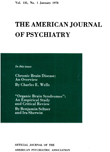Estimating the genetic contribution to schizophrenia
Abstract
The authors discuss the limitations of the concept of heritability in schizophrenia and, using reported incidence figures, assess two alternatives--the multifactorial and single major locus (SML) models. Both models predict genetic heterogeneity in schizophrenia. For some parameter values, the SML model indicates that homozygotes are rare but at very high risk. According to the multifactorial model, 9.1% of the schizophrenic population has a genetic risk of 99% or more. The authors conclude that neither model adequately accounts for the data but that predictions from both can be used to design sampling procedures which will increase the probability of selecting for study individuals whose illness is highly genetically determined.
Access content
To read the fulltext, please use one of the options below to sign in or purchase access.- Personal login
- Institutional Login
- Sign in via OpenAthens
- Register for access
-
Please login/register if you wish to pair your device and check access availability.
Not a subscriber?
PsychiatryOnline subscription options offer access to the DSM-5 library, books, journals, CME, and patient resources. This all-in-one virtual library provides psychiatrists and mental health professionals with key resources for diagnosis, treatment, research, and professional development.
Need more help? PsychiatryOnline Customer Service may be reached by emailing [email protected] or by calling 800-368-5777 (in the U.S.) or 703-907-7322 (outside the U.S.).



